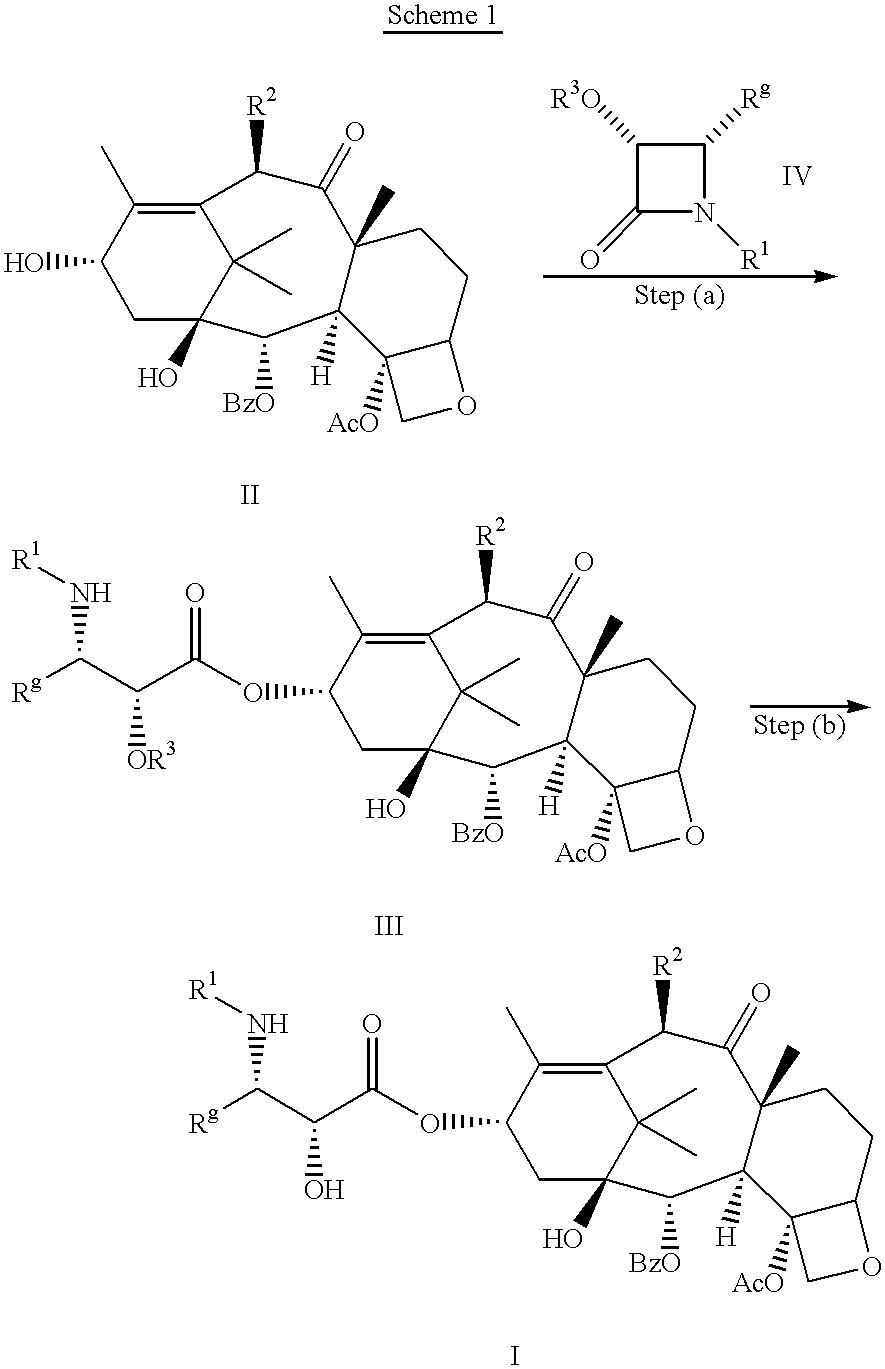Taxane anticancer agents
a technology of anticancer agents and taxane, which is applied in the field of taxane anticancer agents, can solve the problems of inability to provide preparation details and inability to predict the formation of s in vivo, and achieve the effects of preventing or reducing the appearance of sclerosis, preventing or reducing the risk of sclerosis, and significant inhibitory
- Summary
- Abstract
- Description
- Claims
- Application Information
AI Technical Summary
Problems solved by technology
Method used
Image
Examples
example 1
##STR8##7-Deoxy-paclitaxel. (1) The 2'-O-triethylsilyl-7-deoxy-6,7-olefin of paclitaxel (1.2 g, 1.26 mmol) prepared according to the method of Johnson et al. was dissolved in 20 mL of ethanol and 1.51 g of 10% Pd on carbon added. The solution was shaken under an atmosphere of 65 psi of hydrogen for 48 hours. The catalyst was removed by filtration and the solution concentrated to give 1.192 g of product (quant.). The product (805 mg, 0.845 mmol) in 20 mL of acetonitrile was treated at 0.degree. C. with 1N HCl (1.69 mL, 1.69 mmol) for 1 hour. The solution was diluted with ethyl acetate and washed with saturated bicarbonate and brine. The organic fraction was dried over MgSO4 and concentrated. The residue was chromatographed over silica gel using 1:1 hexane-ethyl acetate to give 655 mg of product (83% overall yield).
ESIMS m / z 838 (M+H) IR(KBr) 3442 (br), 1733, 1715, 1243 cm-1 1H NMR (CDCl3, 300 MHz) .delta. 8.15 (d, J=7.2 Hz, 2H), 7.72 (d. J=7.2 Hz, 2H), 7.63-7.31 (m, 11H), 6.96 (d, J=...
example 2
##STR9##
7-Deoxy Baccatin III. (2) To a solution of 7-deoxy paclitaxel (461 mg, 0.55 mmol) in 20 mL of methylene chloride and 0.4 mL of methanol was added Bu4NBH4 (283 mg, 1.1 mmol) and the solution stirred for 24 hours. The solution was quenched with saturated NH4Cl and extracted with ethyl acetate. The solution was dried over MgSO4 and concentrated. The residue was chromatographed over silica gel using hexane-ethyl acetate (1:1) to give 249 mg of product (79%).
FABMS m / z 699 (M+Na) IR(film) 3514 (br), 1734, 1712, 1374, 1274, 1242, 1110, 1070, 1018, 754 cm-1 1H NMR (CDCl3, 300 MHz) .delta. 8.09 (d, J=8.6 Hz, 2H), 7.58 (t, J=7.3 Hz, 1H), 7.45 (t, J=7.3 Hz, 2H), 6.44 (s, 1H), 5.59 (d, J=7.3 Hz, 1H)m 4.93 (d, J=9.5 Hz, 1H), 4.82 (br t, 1H), 4.22 (ABq, J=37.0, 8.3 Hz, 2H), 3.81 (d, J=7.2 Hz, 1H), 3.27 (d, J=5.7 Hz, 1H), 2.4-1.4 (m, 6H), 2.25 (s, 3H), 2.19 (s, 3H), 1.69 (s, 6H), 1.08 (s, 3H), 1.04 (s, 3H). Anal. Calcd for C,31H,38O,10: C, 65.25; H, 6.71; N, 0.00. Found: G, 65.06; H, 6.56,...
example 3
##STR10##
4-(tert-butyidimethylsilanyloxy)benzaldehyde. (3) 4-Hydroxybenzaldehyde (20 g, 0.164 mol) was dissolved in DMF (60 ml) and stirred at RT as imidazole (22.3 g, 0.328 mol) and tert-butyldimethylsilyl chloride (32.1 g, 0.213 mol) were added. The reaction mixture was stirred for 16 h. The solution was diluted with EtOAc, washed with water, brine, then dried (MgSO4) and concentrated in-vacuo to afford 24 g of crude 4-(tert-butyldimethylsilanyloxy)benzaldehyde.
1H NMR (CDCl3) .delta. 9.87 (1H, s), 7.79-7.76 (2H, m), 6.94-6.92 (2H, m), 0.98 (9H, s), 0.22 (6H, s).
PUM
| Property | Measurement | Unit |
|---|---|---|
| Rg | aaaaa | aaaaa |
| time | aaaaa | aaaaa |
| temperature | aaaaa | aaaaa |
Abstract
Description
Claims
Application Information
 Login to View More
Login to View More - R&D
- Intellectual Property
- Life Sciences
- Materials
- Tech Scout
- Unparalleled Data Quality
- Higher Quality Content
- 60% Fewer Hallucinations
Browse by: Latest US Patents, China's latest patents, Technical Efficacy Thesaurus, Application Domain, Technology Topic, Popular Technical Reports.
© 2025 PatSnap. All rights reserved.Legal|Privacy policy|Modern Slavery Act Transparency Statement|Sitemap|About US| Contact US: help@patsnap.com



